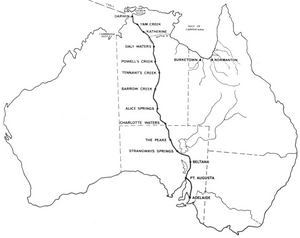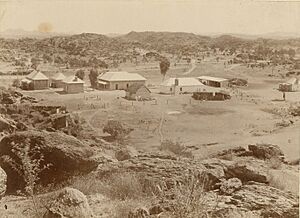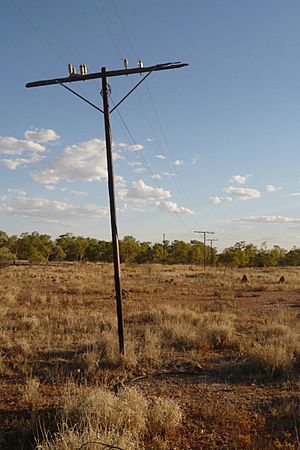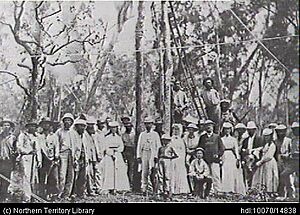Australian Overland Telegraph Line facts for kids

The Australian Overland Telegraph Line was a huge project to send messages across Australia using electric signals and wires. It stretched for 3,200 kilometers (2,000 miles) from Darwin in the Northern Territory all the way to Adelaide, the capital of South Australia.
When it was finished in 1872, this telegraph line changed everything! It allowed Australia to communicate quickly with the rest of the world. Before this, messages to Europe could take months to arrive. After the line was connected to an undersea cable from Java, messages could be sent in just hours. Australia was no longer so far away from everyone else. This line was one of the greatest engineering achievements in Australia during the 1800s.
Contents
Planning the Great Line
By 1855, people in Australia were very excited about connecting to new telegraph cables in Java, which would link them to Europe. They discussed different paths the line could take. One idea was from Ceylon to Albany in Western Australia. Another was from Java to Australia's north coast, then either east or south through the middle of the continent to Adelaide.
The different Australian colonies competed fiercely over which route would be chosen. The government of Victoria even sent an expedition led by Burke and Wills in 1860. They wanted to find a route from Menindee to the Gulf of Carpentaria. Sadly, this expedition ended in disaster, even though they did cross the continent.
The South Australian government saw how much money and power they would gain if the telegraph line went through their territory. They offered a reward of £2,000 to anyone who could find a good route between South Australia and the north coast.
Explorer John McDouall Stuart was also trying to cross the continent. He started from the northern Flinders Ranges and finally succeeded on his sixth try in 1862. A man named James Chambers, who was interested in the telegraph line, paid for Stuart's trips.
As Stuart traveled, he kept the telegraph line in mind. He looked for the best places to cross rivers, find wood for poles, and locate water supplies. On July 24, his team reached the north coast at a spot he named Chambers Bay, after his sponsor. South Australia's Governor, Richard MacDonnell, strongly supported the project.
In 1863, the Northern Territory was given to South Australia. This was done to help secure the land needed for the international telegraph connection. With a possible route now in hand, South Australia became even stronger in its bid for the line. In 1865, their Parliament approved building a telegraph line between Adelaide and Port Augusta, about 300 km (186 miles) north. This made Queensland very upset, as they wanted the line to go through their area.
The final agreement was made in 1870. The South Australian government agreed to build 3,200 km (2,000 miles) of line to Darwin. At the same time, the British-Australian Telegraph Company promised to lay the undersea cable from Banyuwangi, Java, to Darwin. This cable was supposed to be finished by December 31, 1871. If the land line wasn't ready to connect, South Australia would face big fines.
Building the Line
Charles Todd, who was in charge of telegraphs in South Australia, was put in charge of this huge project. He made a plan to finish it on time. Todd had already built South Australia's first telegraph line and extended it to Melbourne. The contract said the project should cost no more than £128,000 and take two years to build.
Todd divided the route into three sections, each about 600 miles (965 km) long. Private companies would build the northern and southern parts. Todd's own department would build the central section. The telegraph line needed more than 30,000 iron poles, along with insulators, batteries, wire, and other equipment, all ordered from England. The poles were placed about 80 meters (260 feet) apart. Special stations called "repeater stations" were built every 250 km (155 miles) to boost the signal.
Todd put together a team for his central section. This team included surveyors, linesmen, carpenters, and laborers. They left Adelaide with horses, bullocks, and carts full of supplies. Explorers John Ross and Alfred Giles surveyed this central part.
The southern section, from Port Augusta to Alberga Creek, was given to Edward Meade Bagot. He hired Benjamin Herschel Babbage to survey the line. Sites for repeater stations were chosen at Beltana, Strangways Springs, and the Peake.
The company Darwent & Dalwood won the contract for the northern section. They arrived in Port Darwin in September 1870 with 80 men, 80 horses, bullocks, and supplies. Their surveyor was Stephen King Jr..
Building the northern line was going well until the wet season started in November 1870. Heavy rain, sometimes 10 inches (250 mm) a day, made the ground muddy and impossible to work on. Conditions got worse, and the men went on strike on March 7, 1871. They complained about bad food and lots of disease-spreading mosquitoes.
On May 3, 1871, the project overseer, William McMinn, canceled Darwent & Dalwood's contract. He sent all the workers back to Adelaide because not enough progress had been made. The government then had to build an extra 700 km (435 miles) of line themselves. They used all their available resources, even buying horses and hiring men from New South Wales. It took another six months for more workers, led by engineer Robert Patterson, to arrive in Darwin.
As the central and southern sections were almost done, Patterson changed his plan for the northern section. He divided it into four smaller parts, with most of the men working on the very northernmost part. The undersea cable from Java to Darwin was finished earlier than expected, connecting on November 19, 1871.
Charlotte Waters, just north of the South Australian border, was surveyed in 1871. A repeater station was built there in 1872.
Because of the ongoing problems in the northern section, some people wanted to give up and connect the line to Burketown in Queensland instead. But Charles Todd refused to quit. By the end of the year, over 300 km (186 miles) of line still needed to be built. However, messages were already being sent along the completed parts from May 1872. For the unfinished sections, messages were carried by horse or camel. Todd even visited the workers to keep their spirits up. A message he sent on May 22, 1872, took 9 days to reach Adelaide.
The Line is Finished!

More than seven months behind schedule, the two parts of the line finally met at Frew's Ponds on Thursday, August 22, 1872. Charles Todd had the honor of sending the very first message along the completed line. It said:
- WE HAVE THIS DAY, WITHIN TWO YEARS, COMPLETED A LINE OF COMMUNICATIONS TWO THOUSAND MILES LONG THROUGH THE VERY CENTRE OF AUSTRALIA, UNTIL A FEW YEARS AGO A TERRA INCOGNITA BELIEVED TO BE A DESERT +++
After the first messages were sent, Todd traveled back to Adelaide with surveyor Richard Randall Knuckey.
How the Overland Telegraph Line Worked
To make the telegraph work in the 1800s, the signal needed to be boosted regularly. This is why repeater stations were built every 250-300 kilometers (155-186 miles). These stations had special batteries to power the line and the local equipment. Each station had a small team of four to six people, including a station master, telegraph operators, and linesmen.
The southern part of the line first had repeater stations at Beltana, Strangways Springs, and the Peake. In 1884, another station was added at Hergott Springs/Maree. Later, in 1896, the stations at Strangways Springs and the Peake closed. New ones opened at William Creek and Oodnadatta, following the path of the Great Northern Railway.
The telegraph line quickly helped open up the Northern Territory. Gold was discovered in several places along the northern section, especially at Pine Creek. The repeater stations in the MacDonnell Ranges became important starting points for explorers heading west, like Ernest Giles and Peter Egerton-Warburton. In its first year, 4,000 telegrams were sent!
Keeping the line working was a huge, ongoing job. Floods often destroyed poles. In the 1880s, the original wooden poles were replaced with stronger, special metal poles.

In February 1875, some Overland Telegraph employees were traveling from Port Darwin to Adelaide on a ship called the SS Gothenburg. A few days later, the ship sank in a severe storm, and many people, including at least ten telegraph workers, lost their lives.
The final step to connect Australia to the world happened in 1875. The governments of Western Australia and South Australia agreed to build a line across the Nullarbor plain. This was another very difficult project, but it was finished in 1877.
Around 1871, a second undersea cable connected Java with an overland line from Perth to a Cable Station at Roebuck Bay.
During World War II, when Darwin was bombed, the telegraph line was purposely cut just before the attack to prevent its use by enemies.
In 2008, the Overland Telegraph Line was recognized for its amazing engineering history. Markers were placed in Darwin, at the Alice Springs Telegraph Station, and at the General Post Office in Adelaide.
Challenges at Barrow Creek
Life was tough and sometimes dangerous for the workers who lived in isolated stations along the line. On February 22, 1874, about a year and a half after the line opened, a group of Aboriginal men attacked the repeater station at Barrow Creek. A linesman was killed, and the station master was badly wounded. Other workers were also injured. This event was widely reported at the time. A group was sent to find those involved, and some Aboriginal men died as a result.
Australia's Undersea Cable Connections
In 1870, a company called the British Australia Telegraph Company (BAT) was formed. Its goal was to link Australia directly to the British telegraph system by extending a cable from Singapore, through Java, to Port Darwin. Later, in 1873, several British companies joined together to form the Eastern Extension, Australasia and China Telegraph Company (EET Co). A Scottish businessman named Sir John Pender, who founded Cable and Wireless, was a key person behind these British cable companies.
On November 19, 1871, Australia was finally connected to the rest of the world by telegraph. This happened after the BAT company laid a cable from Banyuwangi in Java to Darwin. This date was also very close to when the Overland Telegraph Line from Adelaide to Darwin was completed. The very first message sent directly from London to Adelaide arrived on October 22, 1872. A second undersea cable from Java to Darwin was laid in 1880.
The spot in Darwin where these cables came ashore is still visible during very low tides. It was recognized as a heritage site in 2020.
More Cables and Upgrades
On April 9, 1889, a third undersea telegraph cable started working. This one ran from Banyuwangi, Java, to Cable Beach, Western Australia. From there, it continued overland to Perth. This new cable was added to the two cables already laid in 1871 and 1880 that went from Banyuwangi to Darwin.
This third cable was laid to make communications more secure. The older cables sometimes broke due to earthquakes. The new cable was designed to prevent such problems. It was laid by a British company called the Telegraph Construction and Maintenance Company for the Eastern Extension, Australasia and China Telegraph Company. The work took only 10 days and was finished on February 26, 1889.
Cable Beach is named after this cable, which connected Java to the Cable Station there. This station was used until March 1914. After 25 years of operation, it closed because newer, cheaper ways of sending messages became available. Most of the cables were later removed.
The Cable Station building was left empty. In 1921, it was bought and turned into the Broome Court House, which is still used today. It was added to the Western Australian State Register of Heritage Places in 2001 because it is the only original cable station building still standing in Australia.
Today, a cable connects at Onslow on the Western Australian Coast.
Films and TV Shows
In the 1930s, a film company called Cinesound Productions planned to make a movie about the Telegraph Line, but it never happened.
In 2007, the ABC (Australian Broadcasting Corporation) made a TV series called Constructing Australia. It included an episode about the Overland Telegraph Line, as well as the Sydney Opera House.
See Also
- First transcontinental telegraph line across the western United States, completed in 1861
- History of telegraphy in Australia
|




